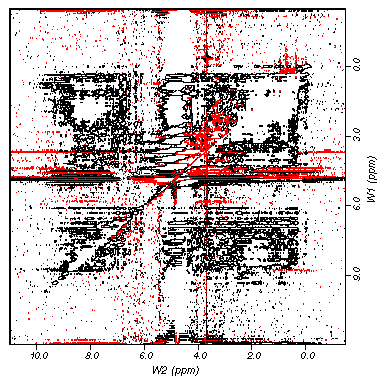
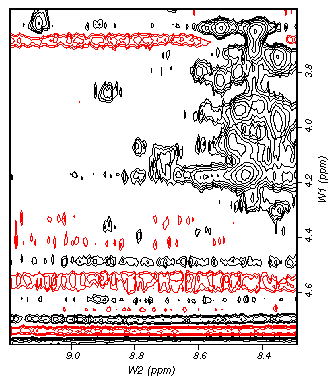
There's a Felix macro to expedite finding optimum Facelift parameter sets
For optimium viewing please resize your browser window so that the two plots (full spectrum and fingerprint details) display side-by-side.
We all know that success in analyzing and qunatifying NMR spectra critically depends on the quality of the baseline. There is a vast a number of ways to achieve a reasonable baseline, but in my own experience only a few methods are truly useful in ND NMR. What follows is a comparison of the abl command available in Felix and the separate program facelift that works with Felix matrizes. In particular, the program facelift was evaluated with a choice of different parameters.
The raw data was a Hahn-echo-NOESY spectrum of reduced human apo-calcyclin.
The sample contains residual EGTA (sharp peaks!).
This spectrum displays relatively broad lines and has a low S/N
ratio. It is thus fairly difficult to properly deal with for most baseplane
correction algorithms, but at the same time one of those that need the best
possible digital wizardry to get good results from it.
Note that polynomial baseline correction was not successful on this dataset at all!
During the processing of this spectrum, the water line was eliminated with a digital low-pass filter (cnv 0 20 0) and a individual transformed F2 vectors were baseline-corrected with third degree polynomial prior to the FT along t1.
The Hahn-echo in the pulse sequence already yields a very good baseplane overall. The low-pass filter can eliminate baseline roll due to out-of-phase contributions from the water resonance. I haven't checked how much of this there is in this spectrum, I simply apply the filter routinely. What's left are mostly ridges along F2 originating from the water, EGTA and other strong lines. These obstruct many details in the fingerprint and adjacent regions.


One relatively robust and useful baseline correction algorithm available in Felix is the abl command. It convolves baseline point with a moving average, interpolating linearly in non-baseline segments.
ABL parameters: 4 40
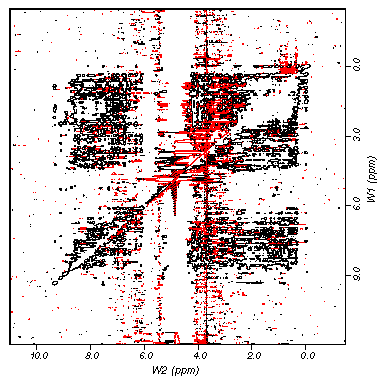
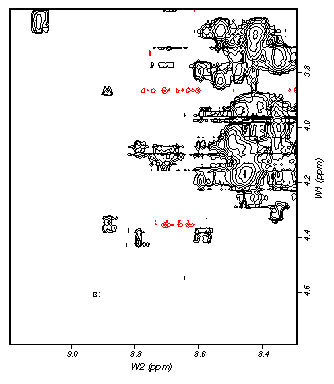
Note that this method actually reduces the noise level in empty regions of the
spectrum. Like all algorithms that treat rows (or columns) individually, it suffers from
potential distortions - witness the expanded plot - and in general yields jagged
contour lines. The parameters used here are good for vectors of 1-2 K points.
Let's look at the best results from facelift:
Facelift parameters: 32 1.5 32 5 (even better would be: 64 1.5 64 5)
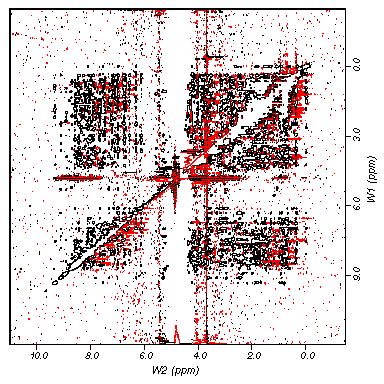
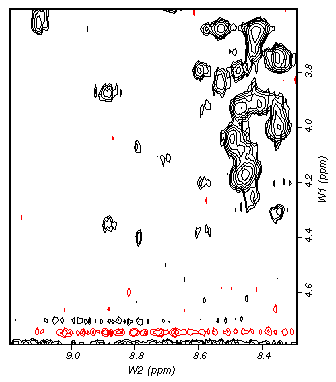
Facelift's salient feature is that it smooths baseline correction over several
vectors orthogonal to the treated dimension, i.e. it does a true base plane
correction. This leaves contour lines smooth and helps to distinguish spikes from true
peaks. In contrast to suggested values in the
manual,
I found that the standard deviation should
be <= 2.0 and the smoothing data window in the orthogonal dimension >= 4 to work
best.
Filter width = smoothing data window in the corrected dimension >= 32 works well.